Macropodus opercularis
Paradise Fish
SynonymsTop ↑
Labrus opercularis Linnaeus, 1758; Labrus operculatus Gmelin, 1789; Chaetodon chinensis Bloch, 1790; Macropodus chinensis (Bloch, 1790); Macropodus viridi-auratus La Cepède, 1801; Macropodus venustus Cuvier, in Cuvier & Valenciennes, 1831; Macropodus filamentosus Oshima, 1919; ? Macropodus baviensis Nguyen [H. D.] & Nguyen [V. H.], in Nguyen [V. H.], 2005
Etymology
Macropodus: from the Ancient Greek μακρός (makrós), meaning ‘long’, and ποδός (podós), meaning ‘foot, leg’, in reference to the long pelvic fins in members of the genus.
opercularis: presumably in reference to the dark opercular spot present in this species.
Classification
Order: Perciformes Family: Osphronemidae
Distribution
Occurs naturally in China, south of the Yangtze (Chang Jiang) River system, including Taiwan and Hainan Island, northern and central Vietnam, and northeastern Laos.
Type locality is ‘Asia’, possibly close to Guangdong in southern China.
Introduced populations exist in a number of countries including South Korea, Japan, Malaysia, Singapore, India, and the U. S. A, mostly as a result of the ornamental trade.
Habitat
This species can survive in a wide range of habitat types and ecological conditions. It can be found in many types of lowland habitat, from streams, river backwaters, and natural ponds to irrigation canals, rice paddies, and artificial reservoirs. In some areas it also inhabits upland hill streams.
Maximum Standard Length
70 – 80 mm.
Aquarium SizeTop ↑
An aquarium with base dimensions measuring 80 ∗ 30 cm or equivalent should be the minimum considered for a single pair.
Maintenance
Can be maintained in a fully-decorated aquarium although many breeders prefer not to use a substrate for ease of maintenance.
Driftwood roots and branches can be used and placed such a way that a few shady spots are formed, while some floating or surface vegetation should be included if the aim is to breed the fish (see ‘Reproduction’).
The addition of dried leaf litter further emphasises the natural feel and as well as offering additional cover brings with it development of microbe colonies which can provide a valuable early food source for fry.
This species can be maintained in an unheated aquarium in most cases, and there is evidence to suggest that it actively benefits from a cool period during winter months.
Water Conditions
Temperature: 10 – 22 °C
pH: 6.0 – 8.0
Hardness: 90 – 357 ppm
Diet
Likely to prey on insect larvae and suchlike in nature, and should be offered small live or frozen Daphnia, Artemia, white worm, grindal worm, etc., in captivity. Some high quality dried products may also be accepted, particularly in the case of commercial strains (see ‘Notes’).
Behaviour and CompatibilityTop ↑
Similarly-shaped fishes should be avoided, but can be maintained alongside peaceful schooling species with comparable environmental requirements.
Males are territorially aggressive, this behaviour becoming more pronounced during reproductive periods, and should not be housed together unless the aquarium is very large. It is also advisable to provide two or more females per male in order to disperse male attention.
Sexual Dimorphism
Males are larger than females and possess extended soft rays in the dorsal, anal, and caudal fins.
Reproduction
Bubble nester. Soft water with a slightly raised temperature is said to induce reproductive behaviour.
The aquarium should have the tightest-fitting cover possible (some breeders use clingfilm/plastic wrap) because the fry need access to a layer of warm, humid air, without which development of the labyrinth organ can be impaired.
The pair need not be separated prior to spawning. The male tends to construct his nest within a raft of surface vegetation, and the female(s) are usually tolerated during this period. Once the nest is complete, the male displays to potential mates using his elongated dorsal, anal, and caudal fins.
The nuptial female becomes paler in colour. Spawning normally occurs beneath the nest in an ’embrace’ typical of osphronemids, with the male wrapped around the female.
At the point of climax milt and a few eggs are released. The latter contain a globule of oil and are lighter than water, therefore they float upwards to the nest, often assisted by the male. The process is then repeated until the female is spent, with several hundred eggs typically deposited.
Post-spawning the adults can normally be left in situ, although cover should be provided for the female. Often the nest becomes broken up and the eggs are instead gathered together into a ‘clump’.
Once the eggs hatch, typically in 3-4 days, they remain in the nest until the yolk sac is fully-absorbed. When the fry begin to swim freely the male will lose interest and the adults are best removed at this stage.
The require an infusoria-grade food for the first few days, after which they can accept motile foods such as microworm and Artemia nauplii. Water changes should be small and regular rather than large and intermittent.
NotesTop ↑
M. opercularis is a classic aquarium fish, having been introduced to the hobby by a French soldier named Gerault in 1869. Of the initial 100 specimens shipped, 22 survived and were successfully bred later that same year by another Frenchman, the Parisian Pierre Carbonnier. This gives the species the distinction of being one of the very first ornamental fish imported to Europe. It is also known as ‘Chinese fighting fish’, ‘paradise gourami’, and ‘blue paradise fish’.
Wild examples are uncommon in the aquarium hobby, since the species is farmed on an extensive basis. There also exist a number of selectively-bred ornamental strains including xanthic, albino, red, blue, and stripeless forms.
It can be distinguished from congeners by the following combination of characters: caudal-fin forked; dark brownish opercular spot with reddish posterior margin in life; 7-11 blue body bars on red background in life; eye stripe connecting spot on posterior projection of opercle with eye; dorsal surface of head and predorsal region with dark spots; posterior margins of body scales not darker than scales.
Like others in the suborder Anabantoidei this species possesses an accessory breathing organ known as the labyrinth, which permits the fish to breathe atmospheric air to a certain extent. Comprising paired suprabranchial organs formed via expansion of the epibranchial (upper) section of the first gill arch and housed in a chamber above the gills, it contains many highly-vascularised, folded flaps of skin which function as a large respiratory surface. Its structure varies in complexity between species, tending to be more developed in those inhabiting harsher environments.
References
- Linnaeus, C., 1758 - Holmiae. v. 1: i-ii + 1-824
Systema Naturae, Ed. X. (Systema naturae per regna tria naturae, secundum classes, ordines, genera, species, cum characteribus, differentiis, synonymis, locis. Tomus I. Editio decima, reformata.). - Freyhof, J. and F. Herder , 2002 - Ichthyological Exploration of Freshwaters 13(2): 147-167
Review of the paradise fishes of the genus Macropodus in Vietnam, with description of two new species from Vietnam and southern China (Perciformes: Osphronemidae). - Ho, H.-C. and K.-T. Shao, 2011 - Zootaxa 2957: 1-74
Annotated checklist and type catalog of fish genera and species described from Taiwan. - Knight, J. D. M. and S. Balasubramanian, 2015 - Journal of Threatened Taxa 7(3): 7044-7046
On a Record of Two Alien Fish Species (Teleostei: Osphronemidae) from the Natural Waters of Chennai, Tamil Nadu, India. - Kottelat, M., 2013 - Raffles Bulletin of Zoology Supplement 27: 1-663
The fishes of the inland waters of southeast Asia: a catalogue and core bibiography of the fishes known to occur in freshwaters, mangroves and estuaries. - Kottelat, M., 2001 - WHT Publications, Colombo: 1-198
Fishes of Laos. - Kottelat, M., 2001 - Environment and Social Development Unit, East Asia and Pacific Region. The World Bank: i-iii + 1-123 + 1-18
Freshwater fishes of northern Vietnam. A preliminary check-list of the fishes known or expected to occur in northern Vietnam with comments on systematics and nomenclature. - Paepke, H-J., 1994 - Neue Brehm Bücherei 616, Westarp Wissenschaften, Magdeburg: 1-144
Die Paradiesfische. - Schindler, I., 2009 - Der Makropode 31(1): 9-12
News on the taxonomy and distribution of Macropodus species. - Wang, T-Z., C-S. Tzeng and S-C- Shen, 1999 - Acta Zoologica Taiwanica 10(2): 121-134
Conservation and Phylogeography of Taiwan Paradise Fish, Macropodus opercularis Linnaeus. - Winstanley, T. and K. D. Clements, 2008 - Zootaxa 1908: 1-27
Morphological re-examination and taxonomy of the genus Macropodus (Perciformes: Osphronemidae).


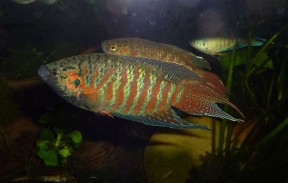

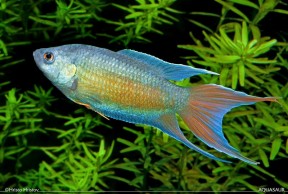
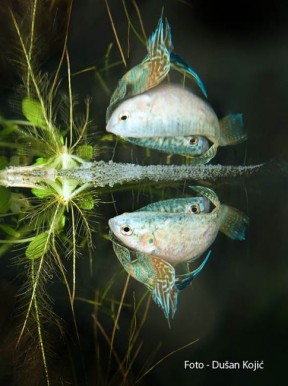


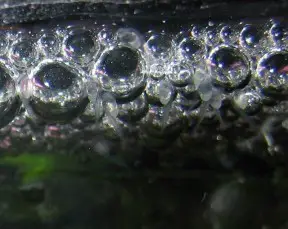

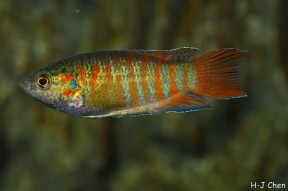



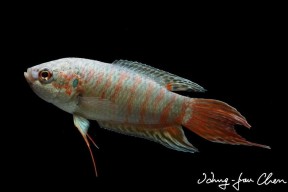



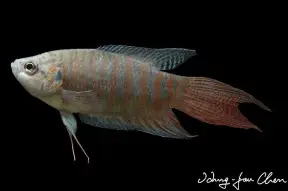

August 3rd, 2014 at 6:37 am
I have kept this fish in a community tank (a 75 gallon long, I find this fish is either aggressive towards fish that are similar looking e.g. Bettas (can be crossbred with) and Dwarf Gouramis (They have the stripe pattern)and towards fish smaller than itself. Some individuals only become aggressive defenselessly.
However,I found this species does well with big fast Danios and Barbs. I have also kept them for years with Spotted and Snakeskin gouramis, with the males of the two mentioned species dominating Paradise Fish in territorial disputes.
Furthermore good sized bottom dwellers like Cory Cats seem to be ignored. I think you have overstated the aggressiveness of this species towards tank-mates. I found some individuals to be completely passive while other are much more territoriality aggressive. Most of the Paradise Fish I have kept have been mildly aggressive. I would also suggest adding photos of the blue color morph and female fish. Thank you for your time.
February 28th, 2018 at 11:21 pm
Is the temperature between 10.º Cº and 22.º Cº correct?
Because I´ve read at http://www.fishbase.org/summary/4777 and it is stated that the temperature should be between 16.º Cº and 26.º Cº :
«Environment / Climate / Range Ecology
Freshwater; pelagic; pH range: 6.0 – 8.0; dH range: 5 – 19. Tropical; 16°C – 26°C (Ref. 1672); 30°N – 20°N, 102°E – 122°E»
Thanks.
January 16th, 2020 at 3:21 am
There are no introduced population of m.opercularis in south korea, maybe confused with m.ocellatus which is native in here.
February 10th, 2020 at 9:34 pm
Until recently, I’ve kept and bred opercularis for many years. Aggression is greatly limited by giving each pair a “home” at the surface. A clump of water sprite does the trick. Actually a thick layer of the plants on the surface will allow more than one pair maintain a territory and leave other fishes and pairs alone. If they don’t see other pairs and below surface, other small fish are not bothered.
A thirty inch long tank would hold two breeding pairs, sometimes three. Thirty six inch long tanks even better.
Once they have a territory, it becomes very interesting in that Macropodus eggs float, unlike other anabantids where the eggs sink. They may not even bother with much or any of a bubble nest. They will make a space in the dense plants to nest and keep the eggs in the internal space they carved out. Females will even help the males maintain the fry in the nesting area.
They lose interest in the fishes you may have below as they depend on the matts of plants they live in.
To raise the fry, you can remove the fry to a tank with no plant cover. No territory to claim, means no fighting. I’ve kept many other species with them while they are breeding with no incidents.
I had hybridized them with the various other Macropodus
varieties / species and turned out some gorgeous fish.
Unfortunately I lost all due to two months in the hospital. It was great fun while it lasted.
PS: this works for some of the wild type Betta splendens complex as well.